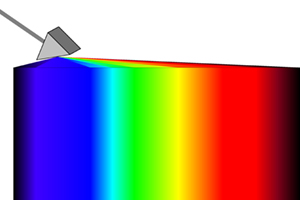 Learn About Color
Learn About Color
Nature of Color

Light is a form of electromagnetic energy. It is those wavelengths (or frequencies) of electromagnetic energy to which the human visual system is sensitive. Energies at wavelengths above the visible band (lower frequencies) include infrared (heat); wavelengths below the visible band (higher frequencies) include ultraviolet, x-rays, etc. To be more specific, the visible spectrum comprises the wavelengths from just below 400 nanometers1 (nm) through those just over 700 nm; from violet through blue, green, and yellow to red.
The sun, a source of light energy in the visible spectrum, is an illuminant. A point on an object such as the fire engine absorbs some light—some wavelengths more than others—and reflects the remainder (we may also see light transmitted through an object). Some of the reflected light reaches the retina of your eye, the observer From this band of stimulation, the brain experiences a perception—a single color. If we change just the illuminant, or just the observer, we change the color.

